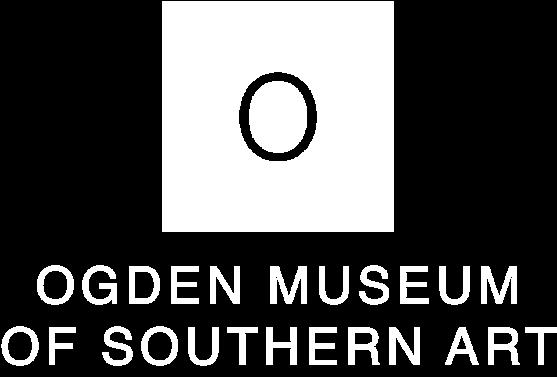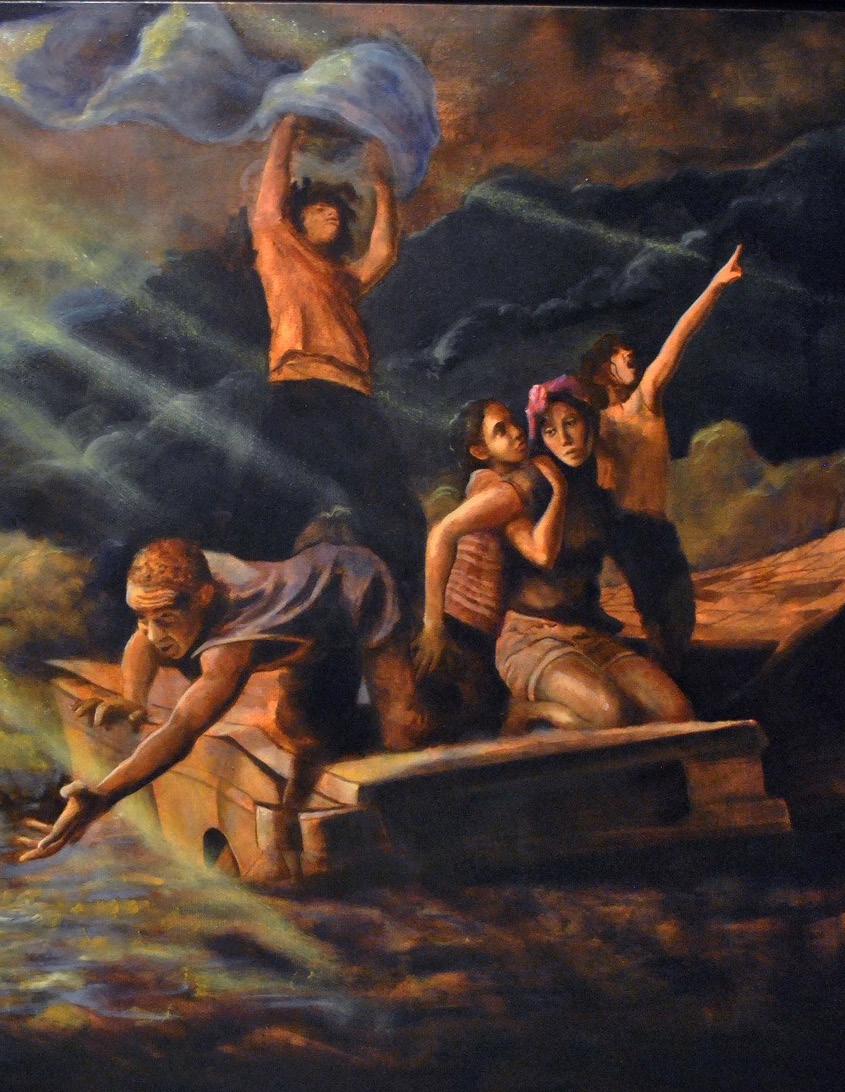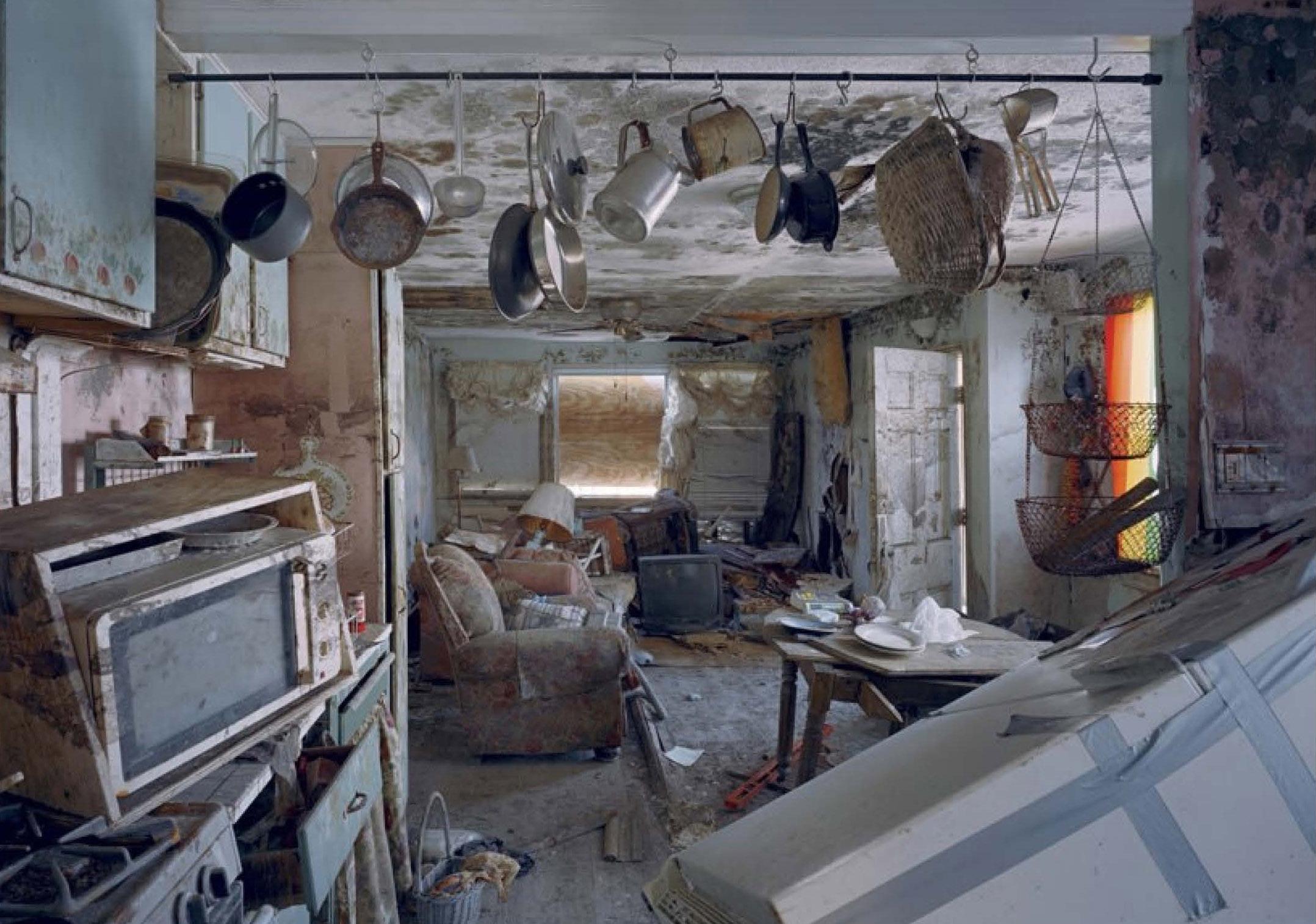




925 Camp Street, New Orleans, LA ogdenmuseum.org | @ogdenmuseum
On August 29, 2005, Hurricane Katrina brought devastating winds, rainfall and storm surge to South Louisiana and the Mississippi Gulf Coast. In New Orleans, the storm surge overwhelmed the Federal Levee System, flooding over 80% of the city. On the Mississippi Gulf Coast, the storm’s powerful winds and massive surge obliterated the built and modified environments of coastal communities. Twenty years later, Hurricane Katrina remains one of the most catastrophic disasters in U.S. history. It is estimated that over 1,300 lives were lost, and that damages totaled more that $125 billion. Entire communities were forever changed, if not completely lost.
Hurricane Katrina had a profound and lasting impact on coastal communities, stretching far beyond the immediate aftermath of the storm. The storm’s lasting damage included significant coastal erosion, ecological habitat destruction and widespread contamination of land and water. Additionally, the storm led to major population displacement, economic hardship and long-term health consequences, including mental health issues. Recovery has been steady, and in many cases very successful. Yet looking back, there is no denying that Hurricane Katrina transormed this place in ways we are still struggling to understand.
To mark the 20th anniversary of this historic event, Ogden Museum of Southern Art presents the work of six artists that directly address the storm, its devastation and the resiliency of the people impacted. Through their practice, these artists bore witness to both the physical and psychological damage wrought by the storm. They crafted complex narratives, built monuments to resiliency and offered prayers for recovery. Through their work, they attempted to process this event, and as a result offer that same opportunity for healing to the viewer.
Bradley Sumrall Curator of the Collection, Ogden Museum of Southern Art

“I arrived in New Orleans two weeks after the onslaught of Hurricane Katrina. I was sent there by The New Yorker magazine to cover the devastation that this storm had unleashed on the fragile city. I immediately realized that the scope of this catastrophe was much greater than that I had imagined, and so I took it upon myself to return and follow the evolution of the recovery.
It has long been my conviction that rooms are both metaphors and catalysts for states of being, and are thus an insight into the soul-life of their occupants. We may take a portrait of an individual, and indeed, feel many emotions and imagine their personalities or histories in detail, but I believe that by photographing the interior of an abode we know much more about one’s actual personality and personal values. The interior spaces that I photographed in New Orleans were still moist from the receding flood – and the stench of organic rot, the sagging carpets and waterlogged floorboards made photographing difficult — but it was nevertheless important to me to record for posterity a panorama of mementos of interrupted lives. It is also important to note that the overwhelming majority of these interiors’ occupants are still alive today, living a different life somewhere else. Together with the exteriors, in which I attempted to make visual sense of the forces of chaos that threw houses about as if they were made of cardboard, these photographic records are offered as a kind of visual Last Rites for life trajectories that are no more.”
- Robert Polidori

William (Billy) Solitario’s Hurricane Proof House is a poetic exercise in dualities: land and sky, the natural and the built environment, beauty and destruction. Like so many artists along the Gulf Coast, Hurricane Katrina became a force not only in his life, but in his studio practice, as well. Solitario’s New Orleans studio was destroyed by the storm, as was his parent’s home in Gautier, Mississippi. Hurricane Proof House depicts a scene familiar to those who explored the Mississippi Gulf Coast in the months following the storm, a beautiful and surreal landscape of devastation where the awful and awesome winds and tidal force of Katrina had wiped clear the built environment, with the exception of foundations and stairways leading to empty space. Painted in plain air shortly after the storm, this masterful composition balances a deep sense of loss with an even deeper respect for the power and beauty of nature.

“It was this urgent sense that something was passing away—that it would never be the same—that struck Bates while he watched the horror of Hurricane Katrina embodied by those poor souls whose lives were destroyed. New Orleans was an important place for Bates. He traveled there often as a young man to visit friends, frequent blues festivals and attend Mardi Gras. And now it was gone, its existence confined to his memories. New Orleans is still there. But it will never be the same.
But what struck Bates more than his own loss, were the unbelievable stories of those victims he watched on television: the incredible fight for survival, the absurdly tragic stories, the sadness, the human loss. As they told their stories, he knew that they and their stories would soon be forgotten. And, as he has said elsewhere, “without our memories, what do we have?” Even memories of grief assert and preserve the integrity of the individual. And even if these memories are tragic, the faces that speak them, that live them, nonetheless deserve to be preserved if nothing else as means to preserve the dignity of their humanity.
And so Bates set to work, sketching the portraits of those victims whose stories were being told on television.”
- “The Storm: Works by David Bates” by Daniel A. Siedell, 2008

“In Wrath of Katrina, I didn’t want to focus on the destruction, but to capture the triumph of the human spirit in the face of adversity by depicting young people struggling to survive and save a baby from the floodwaters.
Born and raised in the New Orleans area, I was entering high school when the hurricane struck. While traces of the storm and its transformative and traumatic effects in my life would show
up in my work, I didn’t think of making a painting about it until visiting the Louvre in France. Standing before Theodore Gericault’s massive The Raft of the Medusa, I saw similarities between his painting and the New Orleans experience after the failure of the Federal Levee System following Hurricane Katrina.
Traditionally, artists of Gericault’s time worked in the “grand manner,” depicting stories that were biblical, mythological or historical. It was rare then for an artist to portray contemporary life. Gericault’s magnum opus not only did that, but exposed the botched handling of the sinking of the Medusa. He also painted a man of color as the peak of the compositional triangle of the painting. This central figure personified hope by flagging down a distant ship. High-ranking officers escaped on lifeboats leaving others to fend for themselves on a raft. I saw parallels between this and the way FEMA handled recovery efforts after Katrina.
I spent a year painting Wrath of Katrina while an undergrad at the Columbus College of Art and Design. Utilizing what I had learned from Gericault’s painting, I began by making thumbnail sketches, figure studies and compositional drawings to determine how to convey the tragedy and humanity of the people affected by the storm.
Years later, and after studying in the Atelier of Juliette Aristides, I approached the subject again in my painting Katrina. While the later work shows more technical prowess and is more representative of my mature style, Wrath of Katrina stands as a breakthrough moment in my studio practice, a painting filled with raw emotion and a passion to tell a story in paint.”
-
Jonathan Hodge

“Boats were an integral part of my early life. My father sold fishing boats and repaired outboard motors in his shop in the Houston Heights. I began drawing boats early on. In the early 1980s, my studio practice expanded to three-dimensional works, and the boat and vessel shape became a recurring theme.
Boats represent transition and transformation – physical, psychological and spiritual. Resurrection was created in 2008 as a response to the recovery and healing of New Orleans after Hurricane Katrina. It also serves as a supplication prayer to the Virgin Mary, seeking her assistance in this healing and rebirth.
Boats hold, secure and protect their travelers from imminent harm, taking then to many forms of higher ground.”
- Sharon Kopriva

Survival not only tells the story of Katrina; it is part of it. The 81-inch high wooden column was fashioned from the trunk of a century-old Louisiana pecan tree felled by the storm. This noble trunk could have been burned to ashes, ground to sawdust or wound up in a landfill. Instead, it found its way into the hands of Sylvaine Sancton, a French-born New Orleans-based sculptor who decided to give it a new life even as her adopted city was rebuilding its own life. The carved surface depicts a series of intersecting waves, evoking the waters that battered and engulfed the city in 2005. The natural veins and striations in the wood trace the growth and evolution of this living organism before it was uprooted and transformed into a tribute to endurance and renewal. Finally, the steel spine suggests the industrial prowess, the engineering know-how, the energy and the creativity of this proud region. For all these reasons, this monumental piece – a paean to nature’s force and man’s indomitable spirit – stands as a tribute to the people affected by Hurricane Katrina.